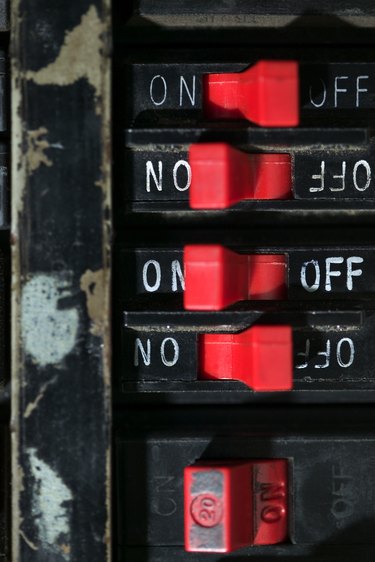
If electricity in your home shorts out or overloads, a circuit breaker may save your life. As the name suggests, a circuit breaker responds to electrical problems on a circuit by shutting off the current. An independent circuit breaker controls only one circuit, but a common-trip circuit breaker can shut down or "trip" several circuits at once.
Poles
Video of the Day
In electric wiring, a pole is a circuit controlled by a circuit breaker. A single-pole circuit breaker trips just one pole. A multi-pole circuit breaker can be set up as a common-trip circuit breaker or to trip any individual circuit under its control without affecting the others. Electricians can set up common-trip circuit breakers on several identical circuits, such as the three wires of a three-phase circuit, or on dissimilar ones, such as the circuits for your air-conditioner's compressor and its cooling fan. Multi-pole independent breakers must be marked to indicate they're not common breakers.
Video of the Day
Tripping
Both independent and common-trip breakers use the same technology to shut down circuits under their control. Magnetic circuit breakers include a magnetic coil that detects and responds rapidly to a dangerous current surge. Thermal magnetic breakers add a thermal element that responds to prolonged, low-level overloads that don't trigger the coil. Thermal breaker units come with a thermal actuator and a mechanical latch that distinguishes between temporary, high-demand current surges and prolonged overloads that must be shut down. Each unit works best on particular kinds of wiring or machines.
Regulation
The National Electrical Code spells out certain situations in which the circuits must have common-trip breakers installed. If any ungrounded electrical conductors are connected to the circuit, for instance, the code usually requires that the electrician install a common-trip circuit breaker. Tripping just one pole on a circuit without a grounded conductor could leave the current without any way to return, creating a hazard for anyone working on the circuit.
Handle Ties
Handle ties enable someone operating a circuit breaker manually to treat an independent breaker as if it were common-trip. The ties link several breakers together, so that when you flip one, the others go too. When an independent breaker trips because of a power surge, however, the breakers it's tied to do not trip with it. This can be hazardous if someone working on the system doesn't realize that the others haven't tripped and approaches it as if a common trip had turned everything off.